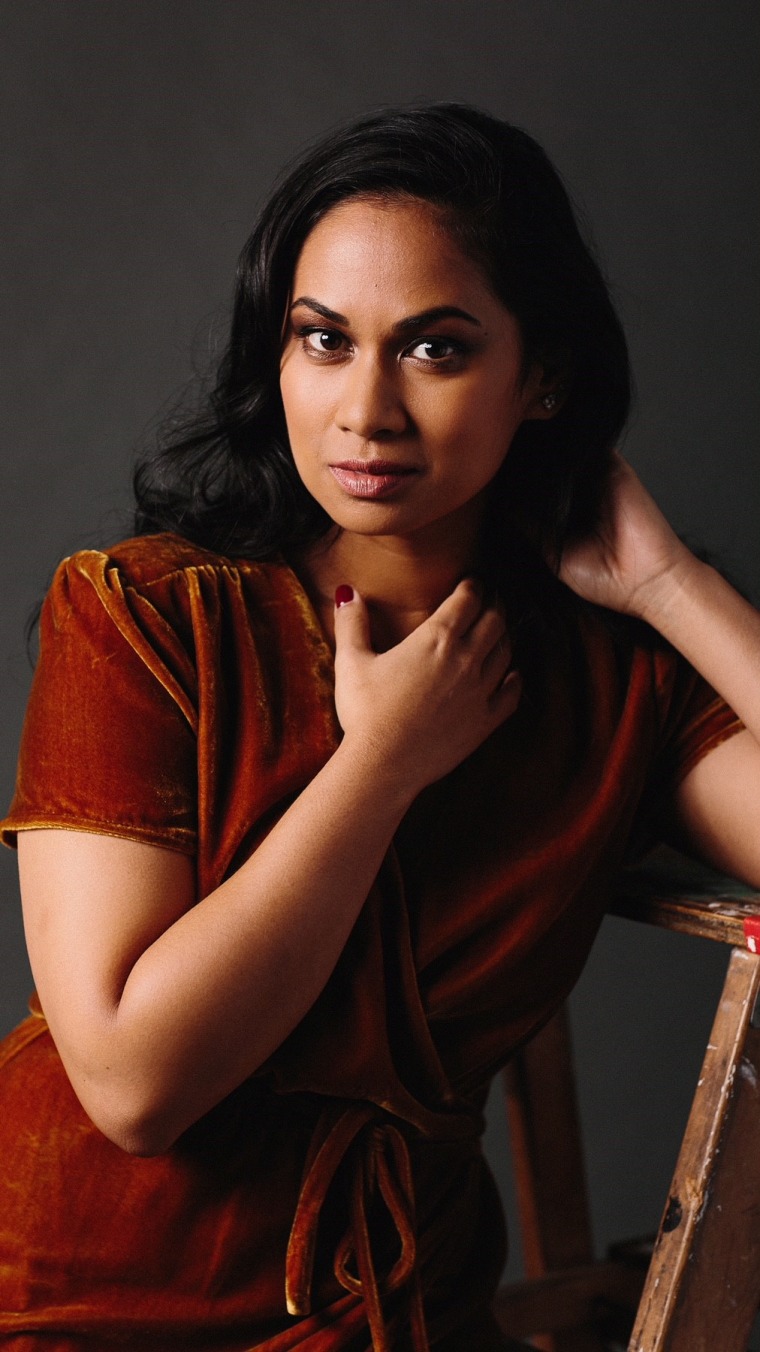We all know what happens when you head to the grocery store without a list. You end up impulsively grabbing items and leaving with a cart piled full of stuff you didn’t really need.
While killing time in the back of a biology class during nursing school, a then 19-year-old Elena Murzello used this “grocery list” theory to create a list of characteristics she was looking for in a potential partner. What Murzello didn’t realize at the time was that this was the first of many “love lists” she would write — eventually leading her to author The Love List: A Guide to Getting Who You Want.
"Without a list, you base your purchases on how hungry you are and end up grabbing random items you don’t need, like pretzel-covered peanut-butter snacks," writes Murzello in the book. "The reevaluation begins when you stare at your half-full grocery cart as you wait in line and realize that you don’t really need half the stuff that you put in your cart. More often than not, you forget the one thing you went shopping for in the first place because it wasn’t so apparent when you were browsing the shelves."
The analogy makes sense. But applying it to her dating life wasn’t a success for Murzello the first time around.

“I wrote 55 characteristics and it had everything from dark denim jeans, to straight teeth, to 5’11” to 6’3” … all this detail,” she told NBC News BETTER. “A month later I ended up meeting my boyfriend at the time and we had a lengthy 10-year relationship. It ended when he went to Vegas for a bachelor party and met a girl. The next weekend he broke up with me; in three months they were engaged, in six months they were married, and then they moved into the apartment that we lived in together. Needless to say, I was disappointed. I kind of went into a hibernation and I went back to grad school."
How did my list fail me? Did it change? Did he personify the list and then I changed? Did I really need a list? These were the questions that ran through Murzellos head.
"I started to interview single, married, divorced people and asked if they’d ever had a list and all the interviews kind of just accumulated and it became the book,” she says. After speaking to more than 100 individuals, she identified the top three characteristics that people were looking for or what those who were married appreciated most about their partners. For women those traits were: Sense of humor, smart and honest, and kind. For men: Attractiveness, sense of humor, and intelligence/ambition.
With this research under her belt, Murzello sat down right before her 30th birthday and crafted a new list. And there was a clear evolution between the characteristics that made the cut now, versus the ones that her 19-year-old self had jotted down 10 years earlier.
“My list from my 20s was 55 characteristics — it had a lot of superficial, physical stuff, and my list at 30 kind of took that away because you know what? Looks do fade," she says. "The things that really matter are those personality-based traits like honesty, trustworthiness, a solid family and friend base, that kind of stuff lasts. I’m still partial to dark denim jeans, but if you don’t own a pair we’ll get you some.”
You need to know who you are before you can know what you want
The book was written five years ago. And since then, some of the married couples she interviewed have divorced. The common denominator Murzello identified between them? They didn’t know themselves, she says.
“I find that some people don’t know themselves enough to be in a relationship, to commit to another person. When people who don’t know themselves get together, you either have to grow together or you grow apart and that’s what I found; a lot of these couples were growing apart because they just didn’t know what they wanted and who they were.”
What about the couples who stayed together? “They are very decisive with their list, and they weren’t willing to compromise. They had deal breakers. Like a healthy lifestyle or having a family … you can’t be sitting on the fence. Those couples really got down to the nitty gritty and said this is where I won’t compromise and this is why we’re lasting because we still have faith in those few characteristics that really drive us through.”
How to Create Your Own Love List
Murzello developed the list as a tool to help people really define what it is they’re looking for in a romantic partner.
“The love list is a list of characteristics and qualities you are looking for in a potential mate,” says Murzello. When it comes to the length of your list, less is more, she says. With 55 characteristics her first time around she casted too wide of a net, which didn't allow her to be as decisive as she should of been. "As I’m pairing it down and being more and more decisive with what I want, I can meet a person and say, ‘Are you right for me? No, you’re off.’”
Ready to give it a try for yourself? Murzello walks us through her four-step process to putting pen to paper and writing your own love list.
- Plan
Be mentally prepared and have an open frame of mind. Take your time and be alone when writing your list. Really reflect on your needs versus your wants, says Murzello.
- Do
Now it’s time to write your list. Put your pen to paper and list out all of the characteristics/qualities you are looking for in a potential mate. “There are no rules and its better if you think ‘blue sky’ versus very narrow,” says Murzello. Don’t censor yourself now, you’ll parse out your list in the next step.
Some questions to consider: What are your deal breakers? How do you value certain characteristics on your list? Will you allow outside influences (family, friends) to dictate what is on your list? Use your experiences, both bad and good, to your advantage, Murzello recommends. Take the bad characteristics and add them to your "no" column and add the good characteristics of people that you've met to the “yes” column.
- Edit
Now is the time to analyze your list. Take out duplicates, couple themes together and delete unnecessary characteristics. An easy way to begin to tailor your list it to keep in mind the Potato Soup versus Lobster theory, Murzello says.
“Why would you go for something bland like potato soup when you could potentially order a lobster? Something unique, something you really want,” she says. “It’s being really clear about what you want and really going for someone who is right for you versus someone who makes you feel safe. Those couples that are in divorce mode right now, a lot of them in their younger years thought ‘I want to get married, here’s a person, I’ll get married to them,’ whether they were right or not. It’s about paring down to someone who is really special for you.”
Why would you go for something bland like potato soup when you could potentially order a lobster?
- Act
Once you have your list, it’s time to get out there and meet people. Refer to your list often and revise it as you learn more about yourself and what you want in a potential partner.
“The last piece of the puzzle is having the list, but letting it go into the universe and being able to recognize when the characteristics pop up and when they don’t,” says Murzello. “Living in the moment is getting out there and not being afraid to see what’s there. Give people a chance, but you don’t want to give people too many chances. Recognize it for what it is and be able to be confident in your decision in what is right for you, and know it’s okay to walk away when it’s not right. Which is hard to do.”
Remember: It’s an ongoing exercise — not a finite list
“It’s a really interesting process at all ages. In your 20s you have to figure yourself out and you want to have a general baseline. So you put it out there and then you explore, you meet people, there's lots of trial and error, and then you start paring down the list,” says Murzello. “You decide some things aren’t important or that you need to add something else. As you evolve as a person, you will have a different list. As you get older priorities change, and it might be helpful to have a concrete list because you tend to forget the things that are important to you. Or you’ll meet someone and realize, 'I do not like this quality at all.' It’s a quick process of elimination.”
Since revising her love list, Murzello says dating has been more fun. "I've concentrated more on personality traits that are important and become more stringent on deal-breakers," she says. "I don't want people to waste my time and vice versa, so I've learned to move on quickly."
Which puts the last line of her book into practice: "You cannot control what happens to you, good or bad; you can only control your own reactions."
And having a love list in your back pocket may just help you react more authentically (and snag your perfect mate in the process).
NEXT: How often do the happiest couples have sex? (It's less than you think)
Want more tips like these? NBC News BETTER is obsessed with finding easier, healthier and smarter ways to live. Sign up for our newsletter and follow us on Facebook, Twitter and Instagram


